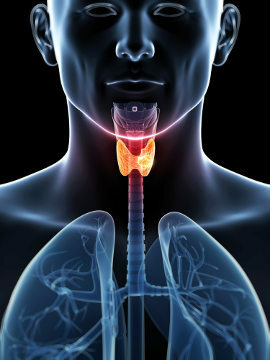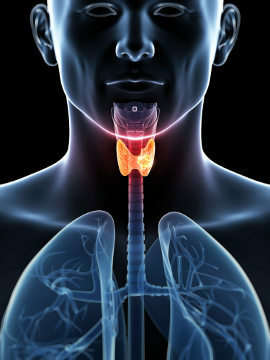O goiter is a problem characterized by an increased size of the thyroid gland, a structure in the shape of butterfly situated in the anterior portion of the neck that is related to the production of two important hormones: triiodothyronine and thyroxine. The increase in the size of this gland is usually associated with a lack of iodine in the diet, an occurrence that configures the so-called endemic goiter.
The enlargement of the thyroid gland in the absence of iodine occurs because this nutrient is essential for the synthesis of thyroid hormones, causing the gland to increase in size as a form of compensation. With the increase, it is possible to see the bumps in the neck region (see the figure above).
Goiter can trigger serious problems, since the exaggerated enlargement of the gland can cause other organs. are affected, especially the trachea and esophagus, which become compressed, causing difficulty breathing and Swallow.
To treat the problem of goiter, medications containing iodine and/or thyroid hormones can be used, in addition to treatment with radioactive iodine, which reduces the size of the gland by radiation. In severe cases, where organ compression occurs, for example, part or all of the gland can be removed. If the thyroid is removed, the patient must use hormones for life.

The thyroid is responsible for the production of two important hormones
Iodine deficiency in the body is not a recent problem, as records indicate that it has been around for more than 5000 years. In 1831, Boussingault, a French researcher, realized that the cause of goiter was iodine deficiency and suggested adding the nutrient to salt to prevent this problem. Despite the French's recommendations, it was only in 1953 that a law was enacted in Brazil that required the iodination of salt. It is estimated that at that time about 20% of the entire population had problems resulting from a deficiency of this nutrient.
After the start of the use of iodized salt, there was a considerable reduction in the number of the disease, which led the technique to be adopted as a preventive form for goiter in various parts of the world. Today, Brazilian table salt has an amount of iodine that varies between 15mg/kg and 45mg/kg. Previously, the value was 20 to 60 mg/kg, but research indicated that excess of the nutrient was harmful to health, which led to a revision of the values.
It is important to note that sometimes goiter does not occur as a result of iodine deficiency. Among the other known causes, we can mention hyperthyroidism, Hashimoto's thyroiditis, tumors, infections and the use of some medications.
By Ma. Vanessa dos Santos


